Reservoir Characteristics and Their Controlling Factors in Siliceous Shales of the Upper Permian Dalong Formation, Western Hubei Province, South China
Abstract
1. Introduction
2. Geological Setting
3. Materials and Methods
4. Results and Discussion
4.1. Mineral Compositions and Lithofacies Classification of the Shales
4.2. Organic Geochemical Characteristics of the Shales
4.3. Characteristics of the Shale Reservoirs and Their Influencing Factors
4.3.1. Physical Characteristics of the Shale Reservoirs
4.3.2. Shale Pore Types
- (1)
- Organic pores
- (2)
- Non-organic pores
- (3)
- Microfractures
4.4. Characteristics of the Shales’ Pore Structures
4.5. Shale Adsorption Capacity
4.6. Comparison with Other Typical Shale Gas Reservoirs
5. Conclusions
Author Contributions
Funding
Data Availability Statement
Conflicts of Interest
References
- Hao, F.; Zou, H.; Lu, Y. Mechanisms of shale gas storage: Implications for shale gas exploration in China. AAPG Bull. 2013, 97, 1325–1346. [Google Scholar] [CrossRef]
- Ma, Y.; Cai, X.; Zhao, P. China’s shale gas exploration and development: Understanding and practice. Pet. Explor. Dev. 2018, 45, 561–574. [Google Scholar] [CrossRef]
- Guo, T.; Zhang, H. Formation and enrichment mode of Jiaoshiba shale gas field, Sichuan Basin. Pet. Explor. Dev. 2014, 41, 28–36. [Google Scholar] [CrossRef]
- Han, S.B.; Zhang, J.C.; Wang, C.S.; Tang, X. Elemental geochemistry of lower Silurian Longmaxi shale in southeast Sichuan Basin, South China: Constraints for Paleoenvironment. Geol. J. 2018, 53, 1458–1464. [Google Scholar] [CrossRef]
- Hu, Z.; Du, W.; Sun, C.X.; Wu, J.; Zhu, T.; Zhao, J.; Yan, C. Evolution and migration of shale facies and their control on shale gas: A case study from the Wufeng-Longmaxi Formations in the Sichuan Basin and its surroundings. Interpretation 2019, 64, SN57–SN70. [Google Scholar] [CrossRef]
- Li, H.; Zhou, J.L.; Mou, X.Y.; Guo, H.X.; Wang, X.X.; An, H.Y.; Mo, Q.W.; Long, H.Y.; Dang, C.X.; Wu, J.F.; et al. Pore structure and fractal characteristics of the marine shale of the Longmaxi Formation in the Changning Area, Southern Sichuan Basin, China. Front. Earth Sci. 2022, 10, 1018274. [Google Scholar] [CrossRef]
- Li, J.; Li, H.; Yang, C.; Wu, Y.J.; Gao, Z.; Jiang, S.L. Geological characteristics and controlling factors of deep shale gas enrichment of the Wufeng-Longmaxi Formation in the southern Sichuan Basin, China. J. Pet. Sci. Eng. 2022, 2022, 4737801. [Google Scholar] [CrossRef]
- Fan, C.H.; Li, H.; Qin, Q.R.; He, S.; Zhong, C. Geological conditions and exploration potential of shale gas reservoir in Wufeng and Longmaxi Formation of southeastern Sichuan Basin, China. J. Pet. Sci. Eng. 2020, 191, 107138. [Google Scholar] [CrossRef]
- Rani, S.; Padmanabhan, E.; Prusty, B.K. Review of gas adsorption in shales for enhanced methane recovery and CO2 storage. J. Pet. Sci. Eng. 2019, 175, 634–643. [Google Scholar] [CrossRef]
- Wu, Z.R.; He, S.; He, Z.L.; Li, X.C.; Zhai, G.Y.; Huang, Z.Q. Petrographical and geochemical characterization of the Upper Permian Longtan formation and Dalong Formation in the Lower Yangtze region, South China: Implications for provenance, paleoclimate, paleoenvironment and organic matter accumulation mechanisms. Mar. Pet. Geol. 2022, 139, 105580. [Google Scholar] [CrossRef]
- Zhu, W.B.; Zhang, X.H.; Zhou, D.R.; Fang, C.G.; Li, J.Q.; Huang, Z.Q. New cognition on pore structure characteristics of Permian marine shale in the Lower Yangtze region and its implications for shale gas exploration. Nat. Gas Ind. B 2021, 8, 562–575. [Google Scholar] [CrossRef]
- Yu, Y.M.; Li, P.P.; Guo, R.X.; Zhao, Y.Z.; Li, S.; Zou, H.Y. Upwelling-induced organic matter enrichment of the Upper Permian Dalong Formation in the Sichuan Basin, SW China and its paleoenvironmental implications. Palaeogeogr. Palaeoclimatol. Palaeoecol. 2021, 576, 110510. [Google Scholar] [CrossRef]
- Chen, S.; Zhu, Y.; Qin, Y.; Wang, H.; Liu, H.; Fang, J. Reservoir evaluation of the Lower Silurian Longmaxi Formation shale gas in the southern Sichuan Basin of China. Mar. Pet. Geol. 2014, 57, 619–630. [Google Scholar] [CrossRef]
- Wang, S.; Dong, D.; Wang, Y.; Li, X.; Huang, J.; Guan, Q. Sedimentary geochemical proxies for paleoenvironment interpretation of organic-rich shale: A case study of the Lower Silurian Longmaxi Formation, Southern Sichuan Basin, China. J. Nat. Gas Sci. Eng. 2015, 28, 691–699. [Google Scholar] [CrossRef]
- Shi, X.; Kang, S.; Create, C.; Wu, W.; Zhao, S.; Zhu, D.; Zhang, H.; Which, Y.; Xiao, Z.L.; Li, Y. Shale gas exploration potential and reservoir conditions of the Longmaxi Formation in the Changning area, Sichuan Basin, SW China: Evidence from mud gas isotope logging. J. Asian Earth Sci. 2022, 233, 105239. [Google Scholar] [CrossRef]
- Wu, L.; Hu, D.; Lu, Y.; Liu, R.; Liu, X. Advantageous Shale Lithofacies of Wufeng Formation-Longmaxi Formation in Fuling Gas Field of Sichuan Basin, SW China. Pet. Explor. Dev. 2016, 43, 208–217. [Google Scholar] [CrossRef]
- Zheng, B.; Mou, C.; Wang, X.; Xiao, Z.; Chen, Y. Sedimentary record of the collision of the North and South China cratons: New insights from the Western Hubei Trough. Geol. J. 2019, 54, 3335–3348. [Google Scholar] [CrossRef]
- Ma, Y.; Fan, M.; Lu, Y.; Guo, X.; Hu, H.; Chen, L.; Wang, C.; Liu, X. Geochemistry and sedimentology of the Lower Silurian Longmaxi mudstone in southwestern China: Implications for depositional controls on organic matter accumulation. Mar. Pet. Geol. 2016, 75, 291–309. [Google Scholar] [CrossRef]
- Xie, W.; Wang, M.; Chen, S.; Vandeginste, V.; Yu, Z.; Wang, H. Effects of gas components, reservoir property and pore structure of shale gas reservoir on the competitive adsorption behavior of CO2 and CH4. Energy 2022, 254, 124242. [Google Scholar] [CrossRef]
- Ma, Y. Major Source Rocks and Distribution. In Marine Oil and Gas Exploration in China; Springer: Berlin/Heidelberg, Germany, 2020; pp. 61–79. [Google Scholar]
- Guo, X.; Li, Y.; Borjigen, T.; Wang, Q.; Yuan, T.; Shen, B.; Ma, Z.; Wei, F. Hydrocarbon generation and storage mechanisms of deep-water shelf shales of Ordovician Wufeng Formation–Silurian Longmaxi Formation in Sichuan Basin, China. Pet. Explor. Dev. 2020, 47, 204–213. [Google Scholar] [CrossRef]
- Liu, W.; Yao, J.; Tong, J.; Qiao, Y.; Chen, Y. Organic matter accumulation on the Dalong Formation (Upper Permian) in Western Hubei, South China: Constraints from multiple geochemical proxies and pyrite morphology. Palaeogeogr. Palaeoclimatol. Palaeoecol. 2019, 514, 677–689. [Google Scholar] [CrossRef]
- Wu, W.; Liu, W.; Mou, C.; Liu, H.; Qiao, Y.; Pan, J.; Ning, S.; Zhang, X.; Yao, J.; Liu, J. Organic-rich siliceous rocks in the upper Permian Dalong Formation (NW middle Yangtze): Provenance, paleoclimate and paleoenvironment. Mar. Pet. Geol. 2021, 123, 104728. [Google Scholar] [CrossRef]
- Chen, F.W.; Lu, S.F.; Ding, X. Pore Types and Quantitative Evaluation of Pore Volumes in the Longmaxi Formation Shale of Southeast Chongqing, China. Acta Geol. Engl. Ed. 2018, 92, 342–353. [Google Scholar] [CrossRef]
- Loucks, R.G.; Reed, R.M.; Ruppel, S.C.; Hammes, U. Spectrum of pore types and networks in mudrocks and a descriptive classification for matrix-related mudrock pores. AAPG Bull. 2012, 96, 1071–1098. [Google Scholar] [CrossRef]
- Wu, L.; Lu, Y.; Jiang, S.; Lu, Y.; Liu, X.; Hu, H. Pore structure characterization of different lithofacies in marine shale: A case study of the Upper Ordovician Wufeng-Lower Silurian Longmaxi formation in the Sichuan Basin, SW China. J. Nat. Gas Sci. Eng. 2018, 57, 203–215. [Google Scholar] [CrossRef]
- Burton, Z.F.M.; Moldowan, J.M.; Magoon, L.B.; Sykes, R.; Graham, S.A. Interpretation of source rock depositional environment and age from seep oil, east coast of New Zealand. Int. J. Earth Sci. 2019, 108, 1079–1091. [Google Scholar] [CrossRef]
- Thompson-Butler, W.; Peters, K.E.; Magoon, L.B.; Scheirer, A.H.; Moldowan, J.M.; Blanco, V.O.; Gonzalez, R.E.; Graham, S.A.; Zumberge, J.E.; Wavrek, D.A. Identification of genetically distinct petroleum tribes in the Middle Magdalena Valley, Colombia. AAPG Bull. 2019, 103, 3003–3034. [Google Scholar] [CrossRef]
- Li, H.; Tang, H.M.; Qin, Q.R.; Zhou, J.L.; Qin, Z.J.; Fan, C.H.; Su, P.D.; Wang, Q.; Zhong, C. Characteristics, formation periods and genetic mechanisms of tectonic fractures in the tight gas sandstones reservoir: A case study of Xujiahe Formation in YB area, Sichuan Basin, China. J. Pet. Sci. Eng. 2019, 178, 723–735. [Google Scholar] [CrossRef]
- Magoon, L.B.; Dow, W.G. The petroleum system. In The Petroleum System—From Source to Trap; Magoon, L.B., Dow, W.G., Eds.; American Association of Petroleum Geologists Memoir 60: Tulsa, OR, USA, 1994; pp. 3–24. [Google Scholar]
- Li, H. Research progress on evaluation methods and factors influencing shale brittleness: A review. Energy Rep. 2022, 8, 4344–4358. [Google Scholar] [CrossRef]
- Yang, W.; He, S.; Iglauer, S.; Guo, X.; Zhai, G.; Zhou, Z.; Dong, T.; Tao, Z.; Wei, S. Porosity Characteristics of Different Lithofacies in Marine Shale: A Case Study of Neoproterozoic Sinian Doushantuo Formation in Yichang Area, China. J. Pet. Sci. Eng. 2019, 187, 106856. [Google Scholar] [CrossRef]
- Xiao, B.; Li, X.; Zhao, Z.H.; Fu, X. Sedimentary tectonic pattern of Wufeng and Longmaxi Formations in the northern margin of Sichuan Basin, South China. Int. Geol. Rev. 2021, 64, 2166–2185. [Google Scholar] [CrossRef]
- Chen, K.Q.; Zhang, D.Z.; Tuo, X.S. Relationship between geological structure and marine shale gas preservation conditions in the western Middle Yangtze Block. Nat. Gas Ind. B 2020, 7, 583–593. [Google Scholar] [CrossRef]
- He, W.G.; Zhou, J.X.; Yuan, K. Deformation evolution of Eastern SichuaneXuefeng foldethrust belt in South China: Insights from analogue modeling. J. Struct. Geol. 2018, 109, 74–85. [Google Scholar] [CrossRef]
- Xu, L.L.; Huang, S.P.; Liu, Z.X.; Zhang, Y.L.; Wen, Y.R.; Zhou, X.H.; Chen, W.; Ren, Z.J.; Wen, J.H. Paleoenvironment Evolutionary Characteristics of Niutitang Shale in Western Hubei, Middle Yangtze, China. ACS Omega 2022, 7, 24365–24383. [Google Scholar] [CrossRef]
- Yin, H.F.; Song, H.J. Mass extinction and Pangea integration during the Paleozoic–Mesozoic transition. Sci. China Earth Sci. 2013, 56, 1791–1803. [Google Scholar] [CrossRef]
- Yin, H.; Jiang, H.; Xia, W.; Feng, Q.; Zhang, N.; Shen, J. The end-Permian regression in South China and its implication on mass extinction. Earth-Sci. Rev. 2014, 137, 19–33. [Google Scholar] [CrossRef]
- Liu, L.; Wu, Y.S.; Li, Y.; Liu, Q.S.; Jiang, H.X.; Liu, H. Microfacies of a Permian calcisponge reef in Lichuan, western Hubei, South China. Palaeoworld 2018, 27, 90–106. [Google Scholar] [CrossRef]
- Liu, W.Q.; Zhang, X.X.; Qiao, Y.; Xu, Y.; Mou, C.L.; Wu, W.; Yao, J.X. Climate-driven paleoceanography change controls on petrology and organic matter accumulation in the upper Permian Dalong Formation, western Hubei Province, southern China. Sediment. Geol. 2022, 440, 106259. [Google Scholar] [CrossRef]
- Zheng, B.S.; Mou, C.L.; Wang, X.P.; Chen, H.D.; Xiao, Z.H. Paleoclimate and paleoceanographic evolution during the Permian-Triassic transition (western Hubei area, South China) and their geological implications. Palaeogeogr. Palaeoclimatol. Palaeoecol. 2021, 564, 110166. [Google Scholar] [CrossRef]
- Cai, Q.S.; Hu, M.Y.; Kane, O.I.; Yang, Z.; Wen, Y.R.; Luo, Q.; Li, M.T.; Hu, Z.G.; Deng, Q.J. Petrological and geochemical characteristics of the Ordovician–Silurian black shale in eastern Sichuan and western Hubei, South China: Differential sedimentary responses to tectonism and glaciation. J. Palaeogeogr. 2022. [Google Scholar] [CrossRef]
- Li, X.M.; Wang, Y.R.; Lin, W.; Ma, L.H.; Liu, D.X.; Liu, J.R.; Zhang, Y. Micro-pore structure and fractal characteristics of deep shale from Wufeng Formation to Longmaxi Formation in Jingmen exploration area, Hubei Province, China. J. Nat. Gas Geosci. 2022, 7, 121–132. [Google Scholar] [CrossRef]
- Espitalié, J.; Madec, M.; Tissot, B.; Mennig, J.J.; Leplat, P. Source rock characterization method for petroleum exploration. In Proceedings of the Offshore Technology Conference, Houston, TX, USA, 2–5 May 1977. [Google Scholar]
- Peters, K.E. Guidelines for evaluating petroleum source rock using programmed pyrolysis. AAPG Bull. 1986, 70, 318–329. [Google Scholar]
- Vandenbroucke, M.; Largeau, C. Kerogen origin, evolution and structure. Org. Geochem. 2007, 38, 719–833. [Google Scholar] [CrossRef]
- Loucks, R.G.; Reed, R.M.; Ruppel, S.C.; Jarvie, D.M. Morphology, genesis, and distribution of nanometer-scale pores in siliceous mudstones of the Mississippian Barnett Shale. J. Sediment. Res. 2009, 79, 848–861. [Google Scholar] [CrossRef]
- Xu, S.; Gou, Q.; Hao, F.; Zhang, B.; Shu, Z.; Lu, Y.; Wang, Y. Shale pore structure characteristics of the high and low productivity wells, Jiaoshiba shale gas field, Sichuan Basin, China: Dominated by lithofacies or preservation condition. Mar. Pet. Geol. 2020, 114, 104211. [Google Scholar] [CrossRef]
- Gou, Q.; Xu, S.; Hao, F.; Lu, Y.; Shu, Z.; Wang, Z.; Wang, Y. Evaluation of the exploration prospect and risk of marine gas shale, southern China: A case study of Wufeng-Longmaxi shales in the Jiaoshiba area and Niutitang shales in the Cen’gong area. GSA Bull. 2022, 134, 1585–1602. [Google Scholar] [CrossRef]
- Xie, W.; Wang, M.; Wang, H.; Ma, R.; Duan, H. Diagenesis of shale and its control on pore structure, a case study from typical marine, transitional and continental shales. Front. Earth Sci. 2021, 15, 378–394. [Google Scholar] [CrossRef]
- Curtis, J.B. Fractured shale-gas systems. AAPG Bull. 2002, 86, 1921–1938. [Google Scholar]
- Jarvie, D.M.; Hill, R.J.; Ruble, T.E.; Pollastro, R.M. Unconventional shale-gas systems: The Mississippian Barnett Shale of north-central Texas as one model for thermogenic shale-gas assessment. AAPG Bull. 2007, 91, 475–499. [Google Scholar] [CrossRef]
- Ji, L.; Zhang, T.; Milliken, K.L.; Qu, J.; Zhang, X. Experimental investigation of main controls to methane adsorption in clay-rich rocks. Appl. Geochem. 2012, 27, 2533–2545. [Google Scholar] [CrossRef]
- Zhang, T.; Ellis, G.S.; Ruppel, S.C.; Milliken, K.; Yang, R. Effect of organic-matter type and thermal maturity on methane adsorption in shale-gas systems. Org. Geochem. 2012, 47, 120–131. [Google Scholar] [CrossRef]
- Burton, Z.F.M.; Dafov, L.N. Testing the sediment organic contents required for biogenic gas hydrate formation: Insights from synthetic 3-D basin and hydrocarbon system modelling. Fuels 2022, 3, 555–562. [Google Scholar] [CrossRef]
- Chalmers, G.R.; Bustin, R.M.; Power, I.M. Characterization of gas shale pore systems by porosimetry, pycnometry, surface area, and field emission scanning electron microscopy/transmission electron microscopy image analyses: Examples from the Barnett, Woodford, Haynesville, Marcellus, and Doig units. AAPG Bull. 2012, 96, 1099–1119. [Google Scholar]
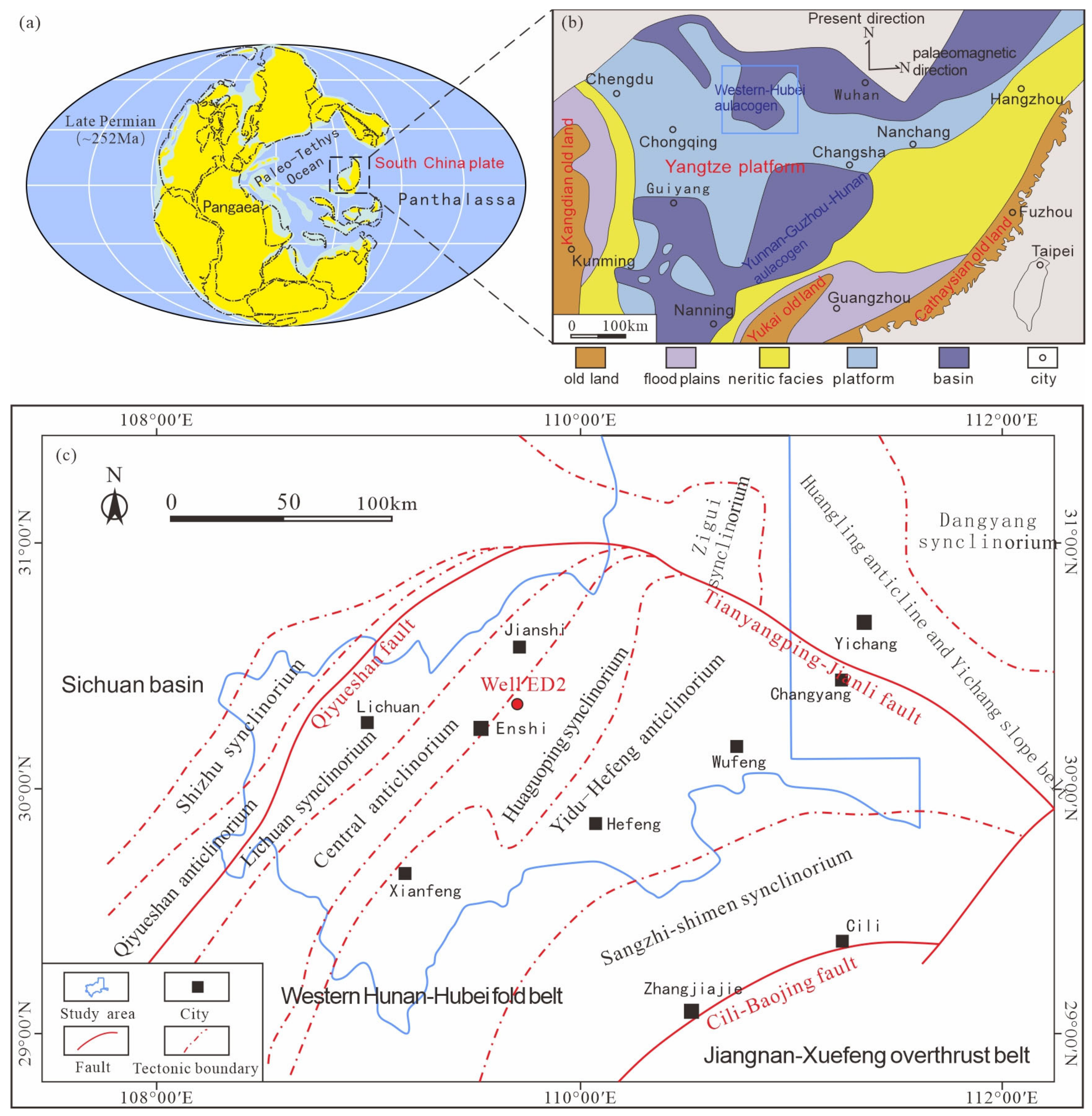
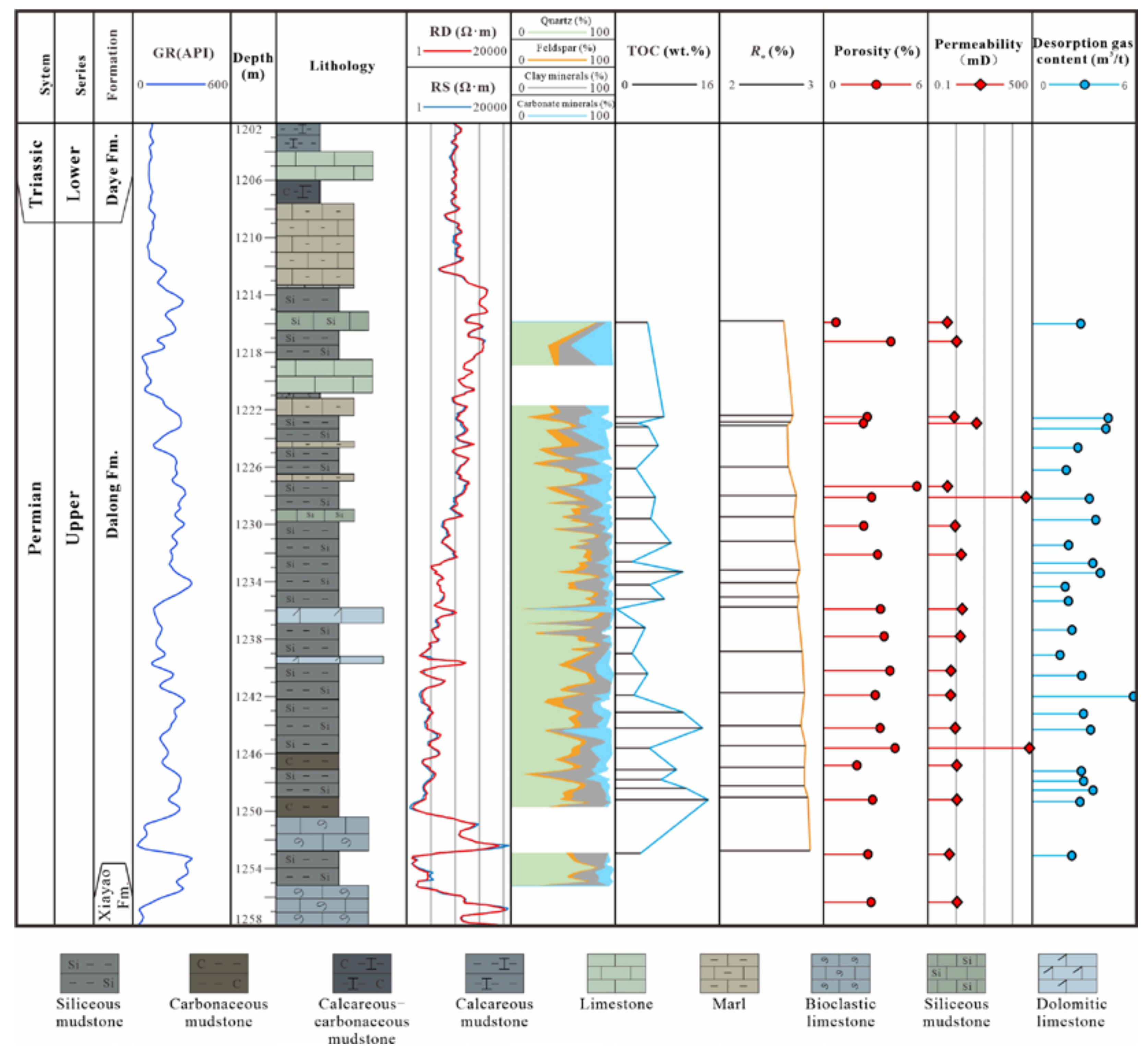
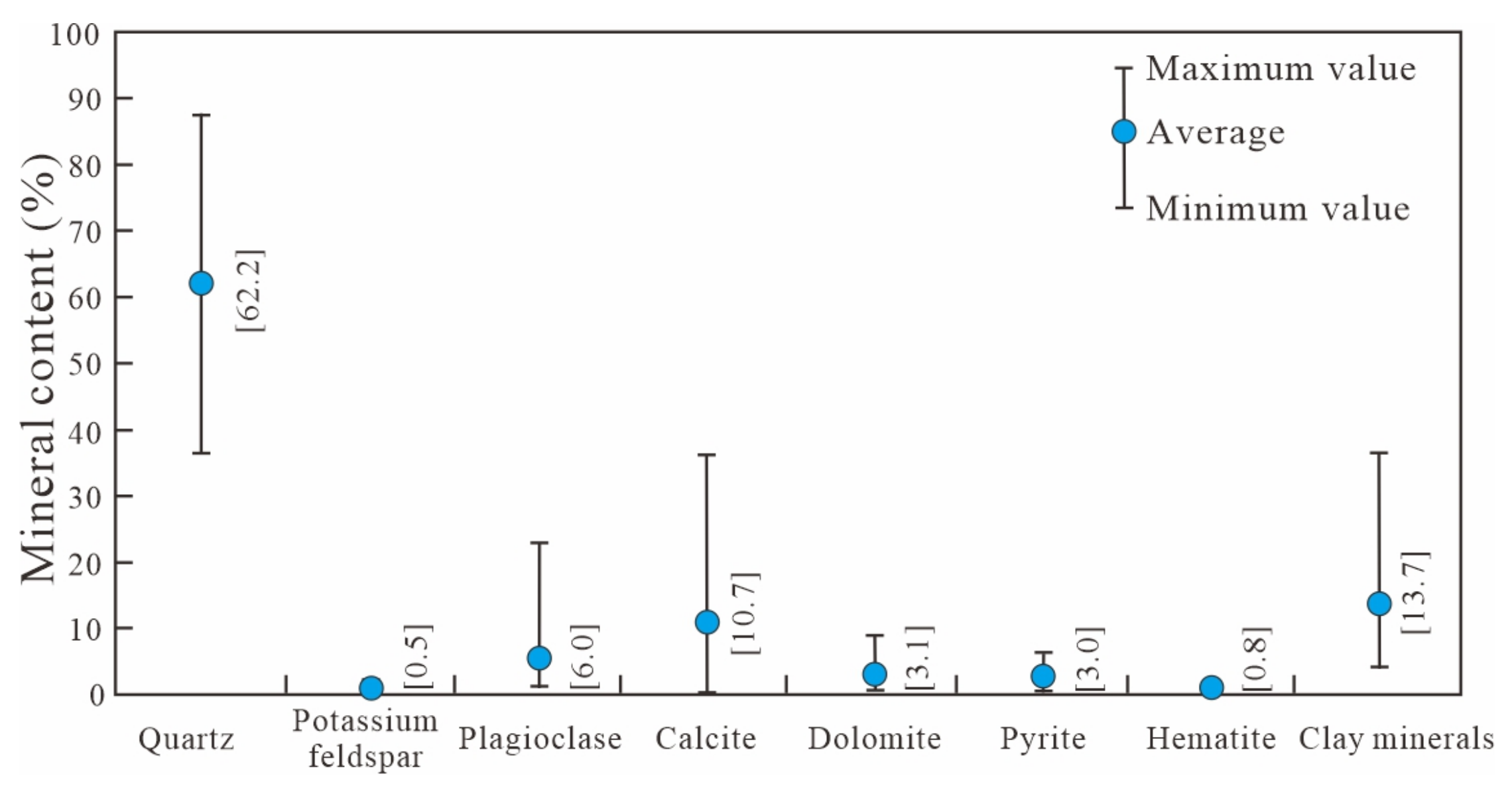

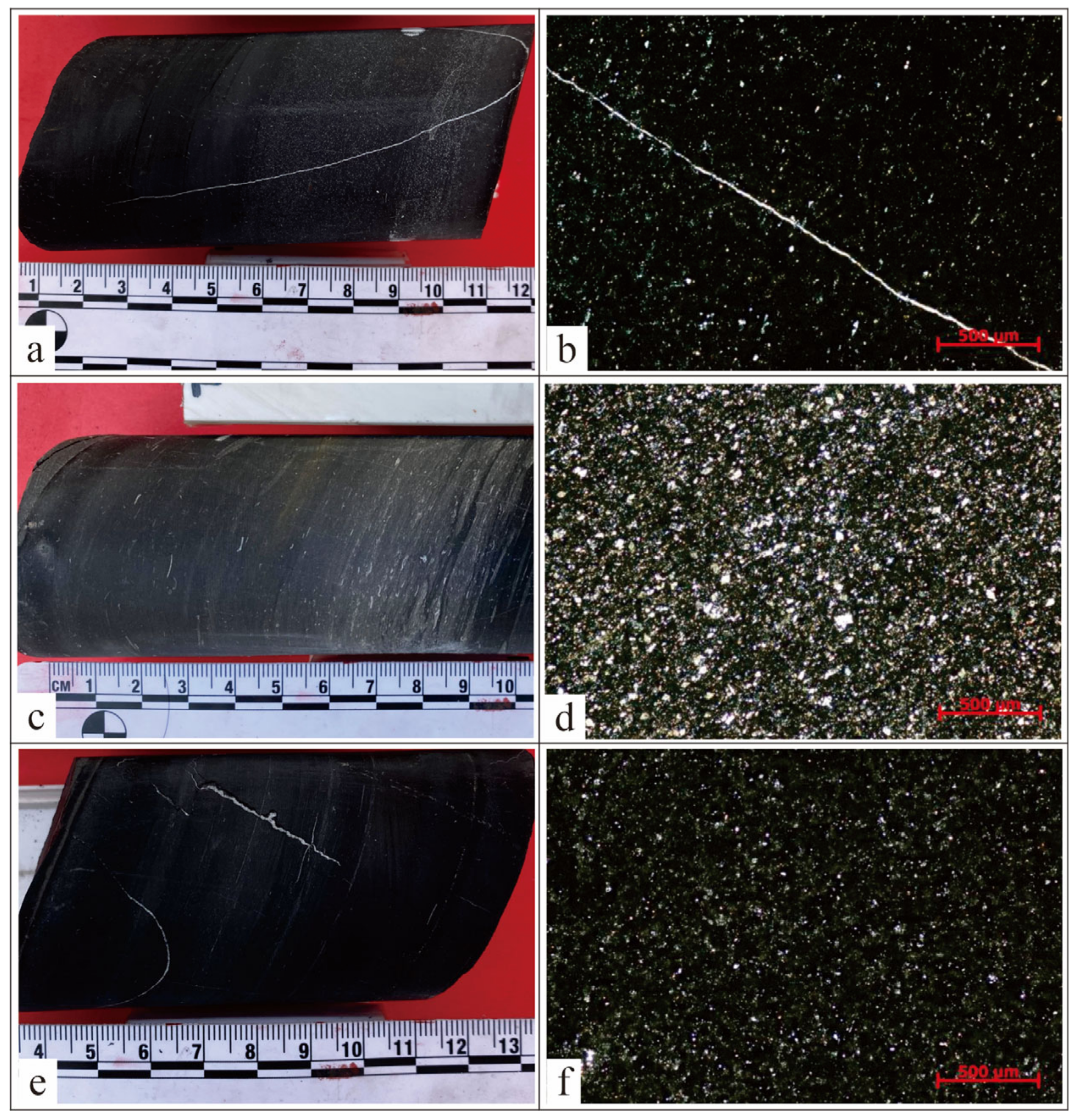
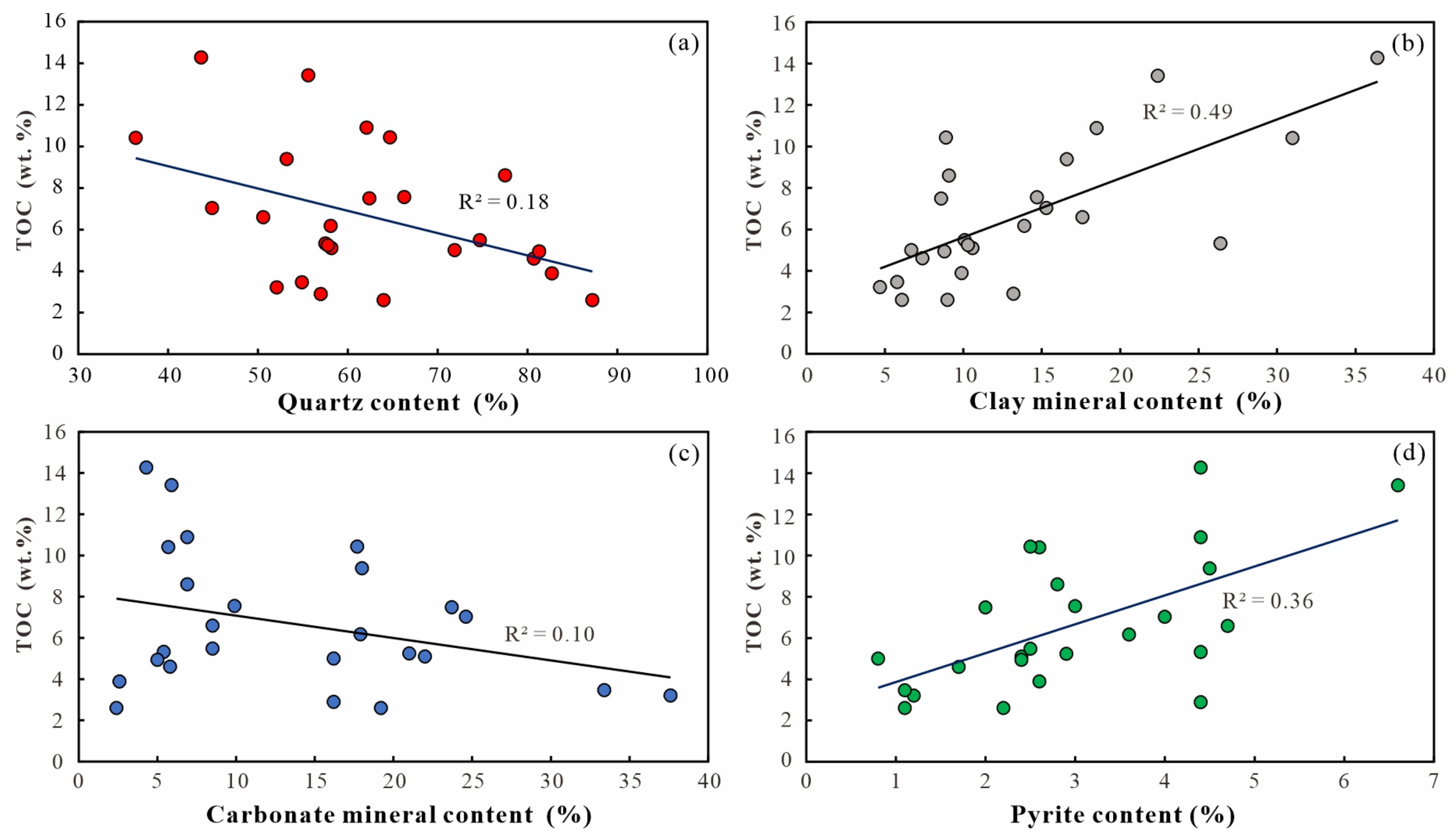
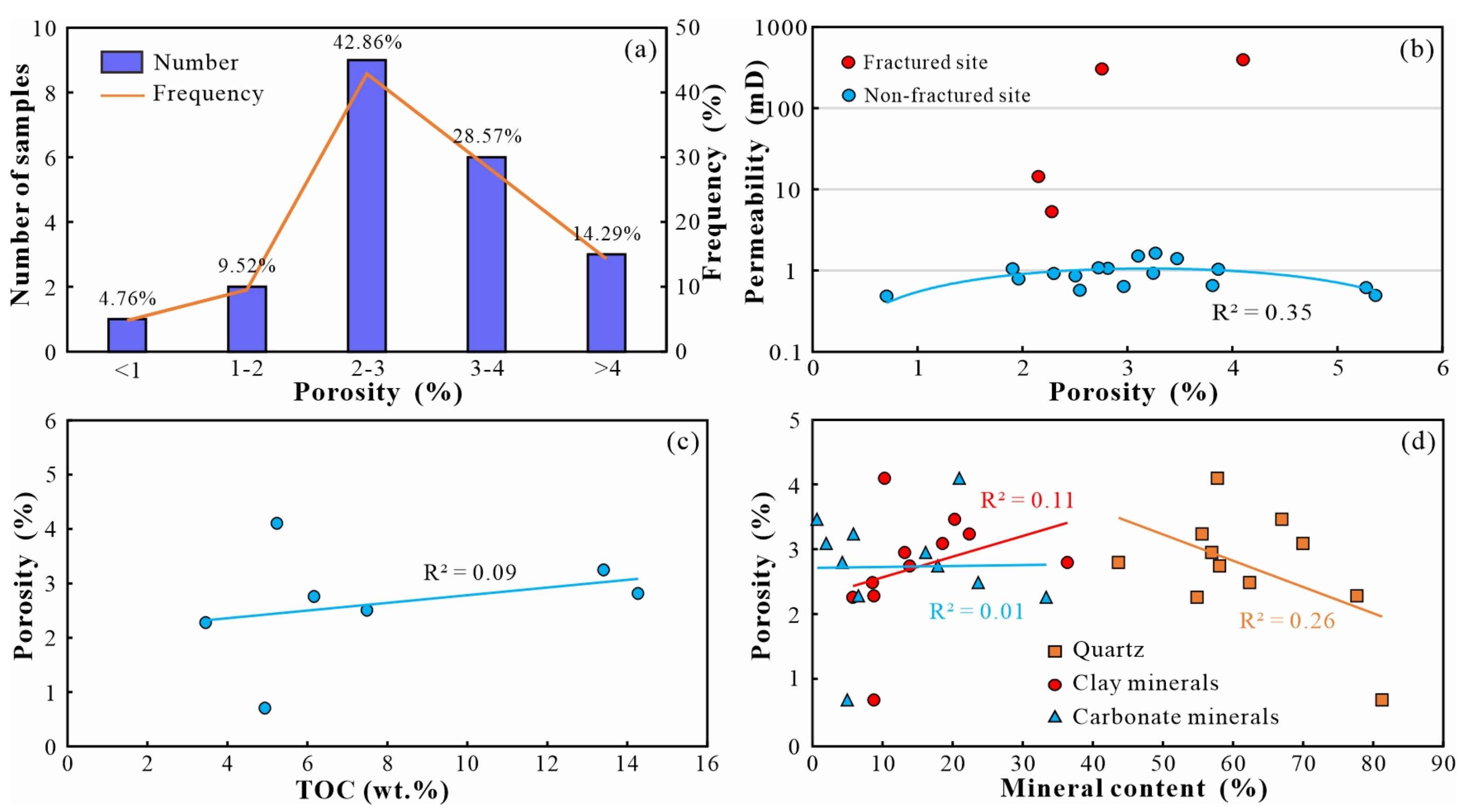
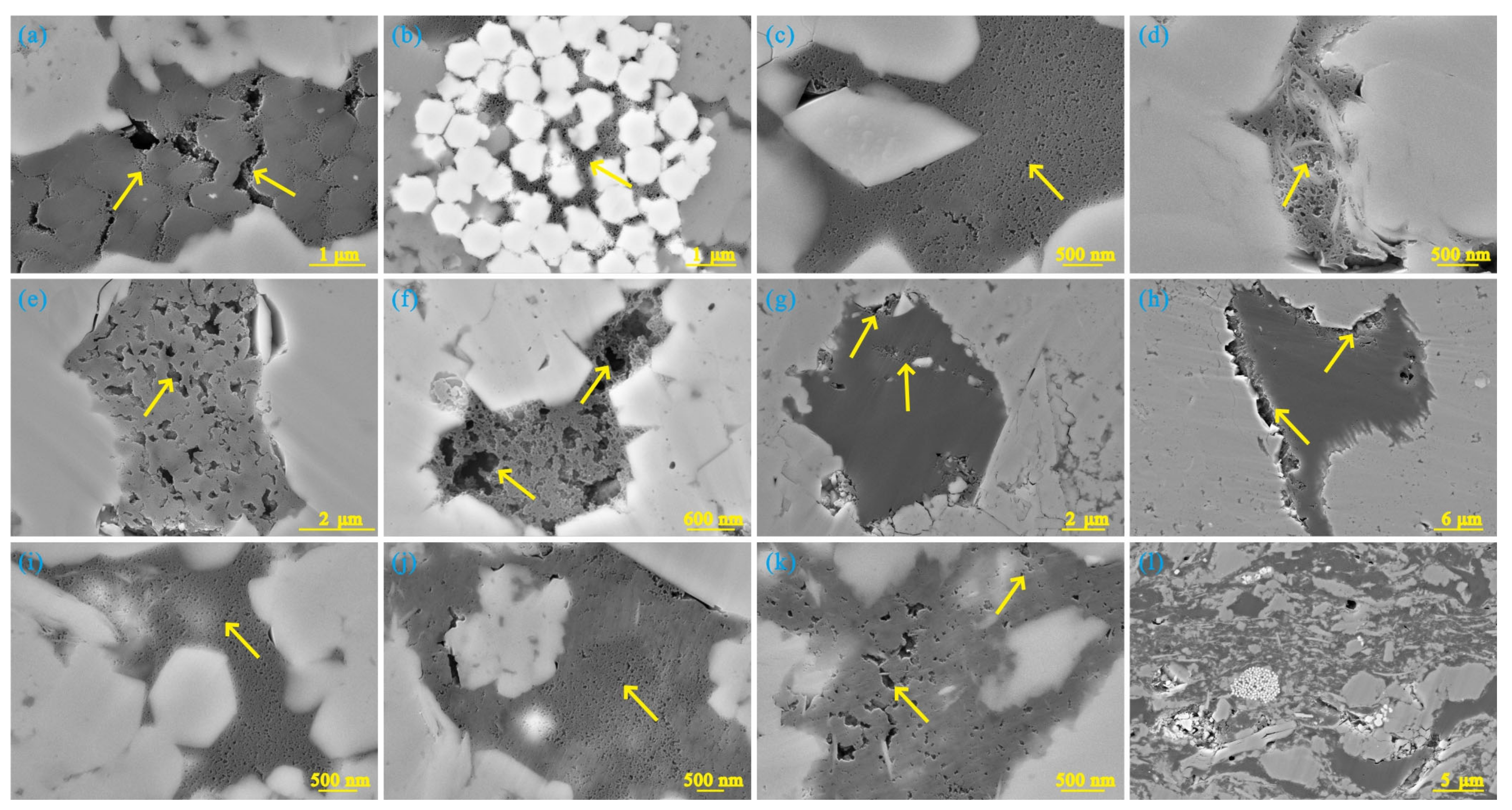
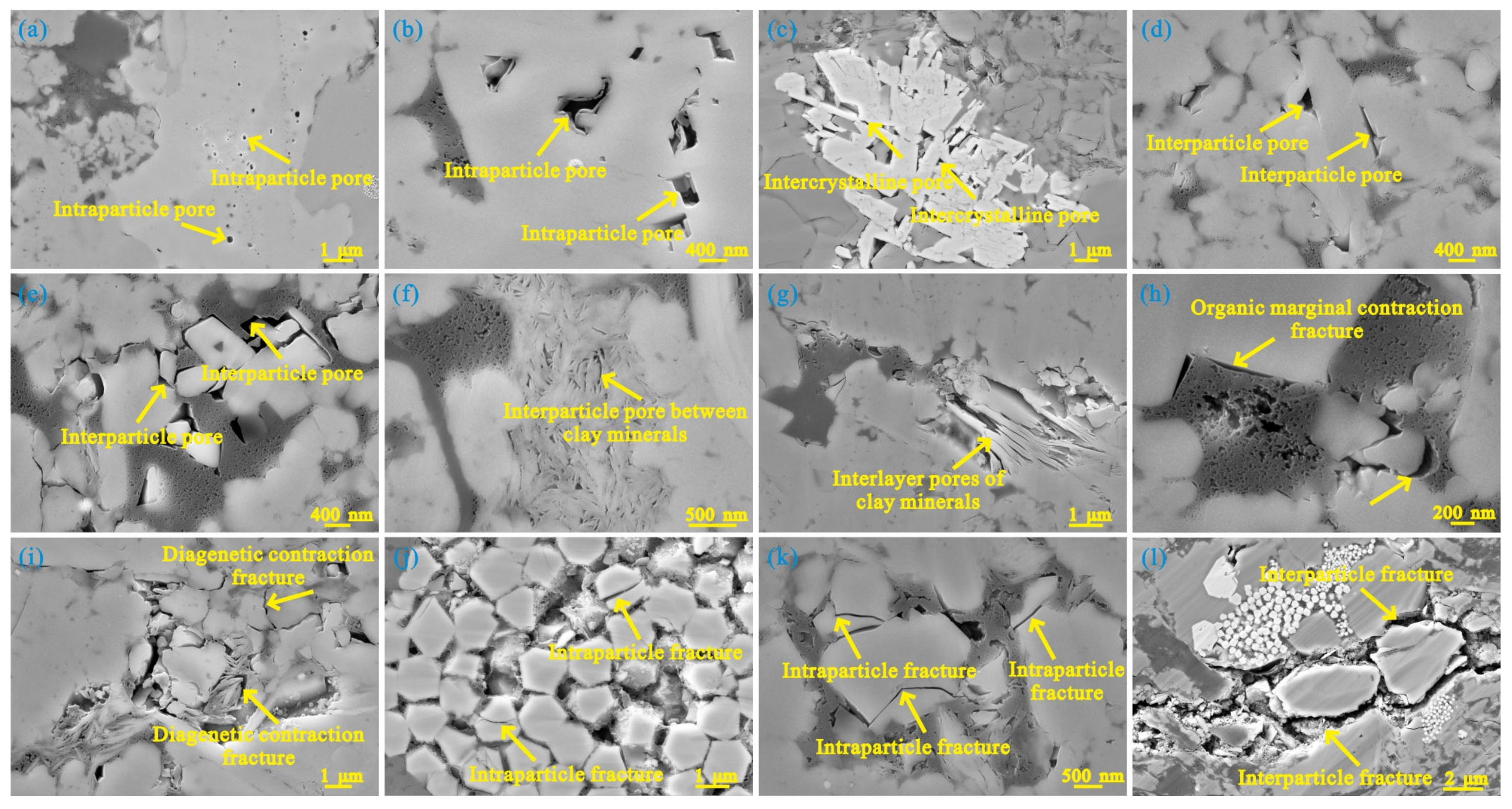
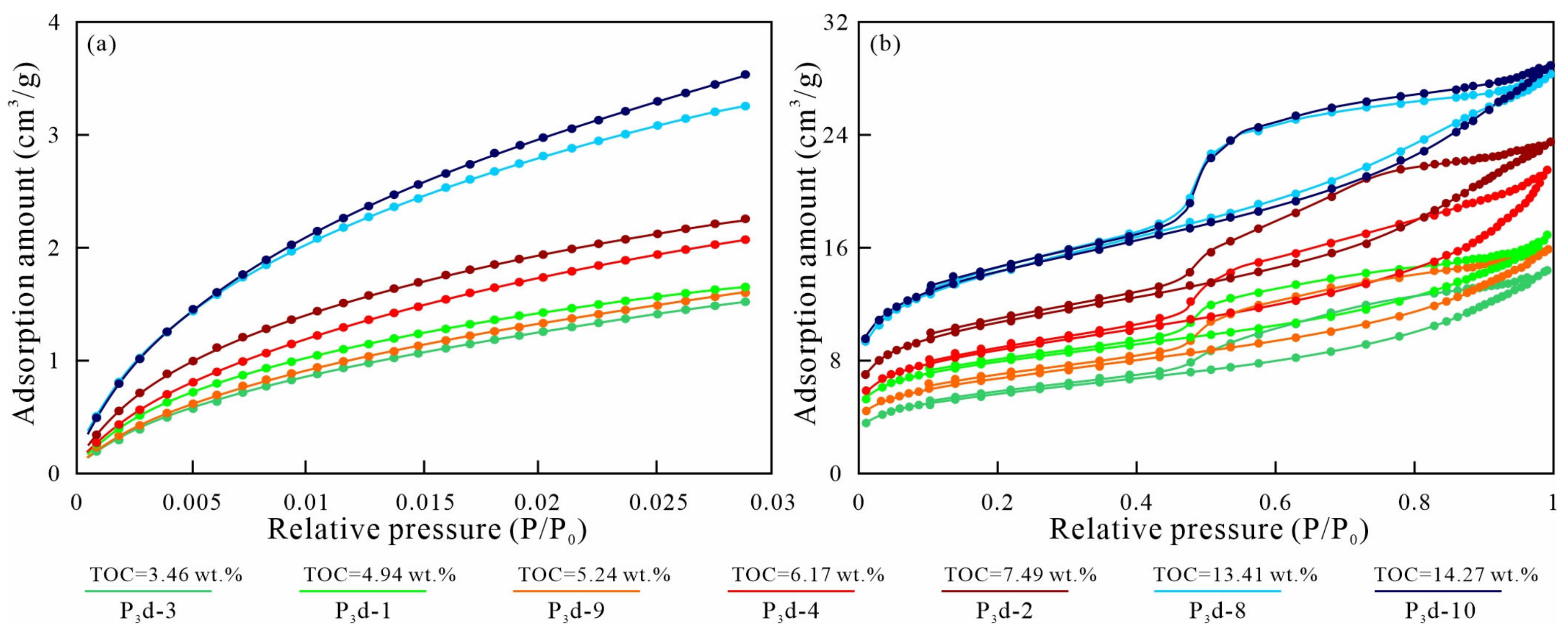
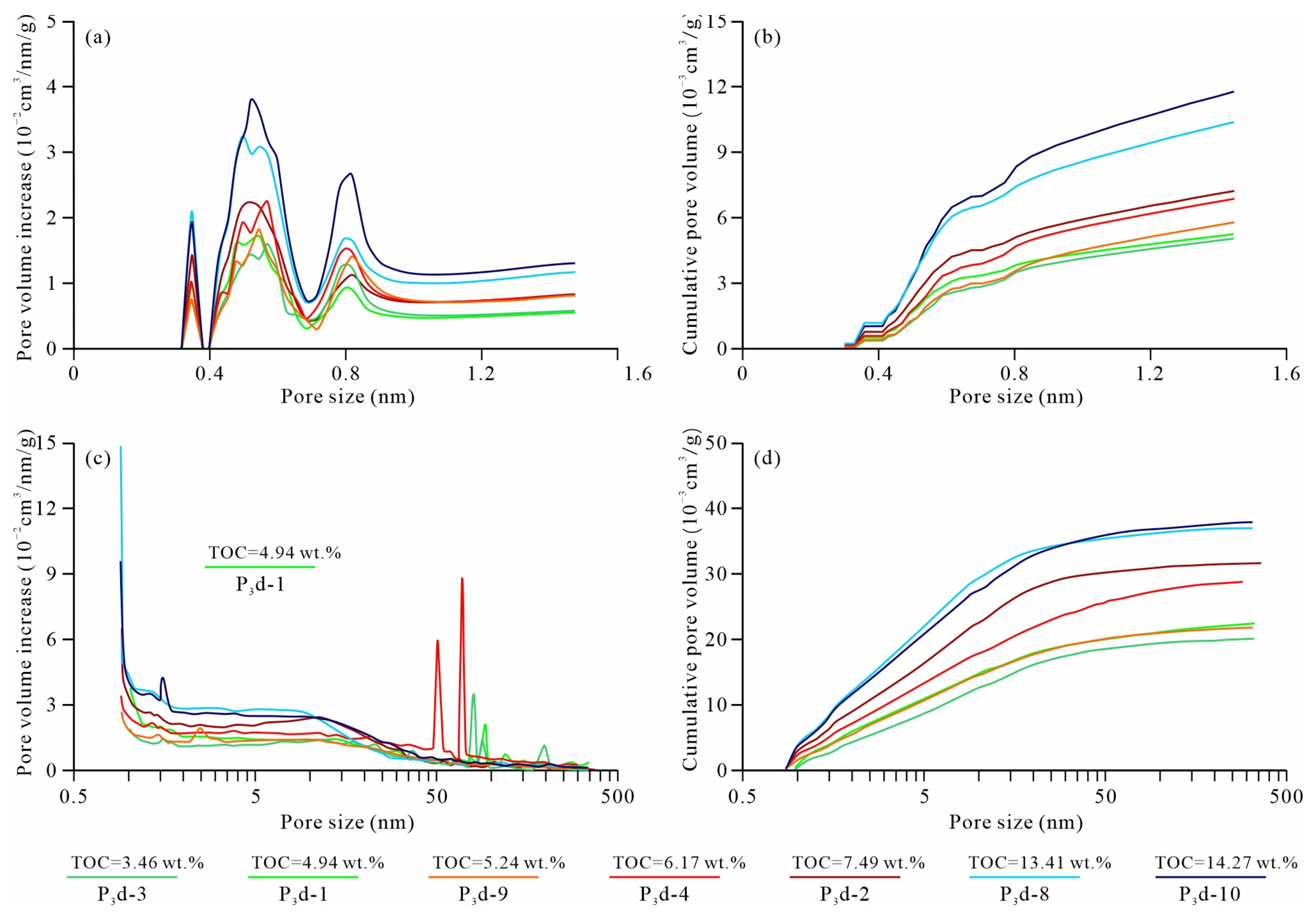
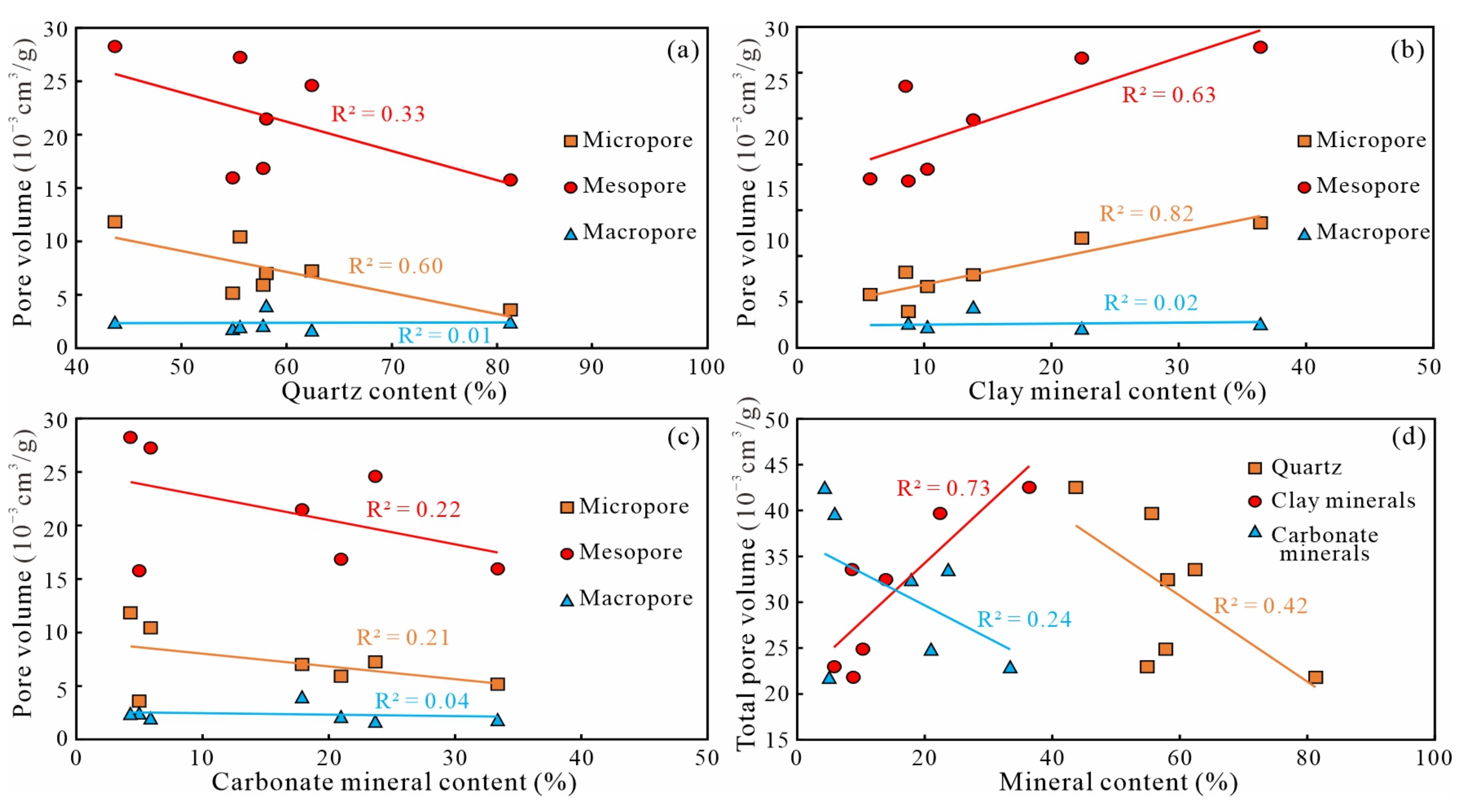

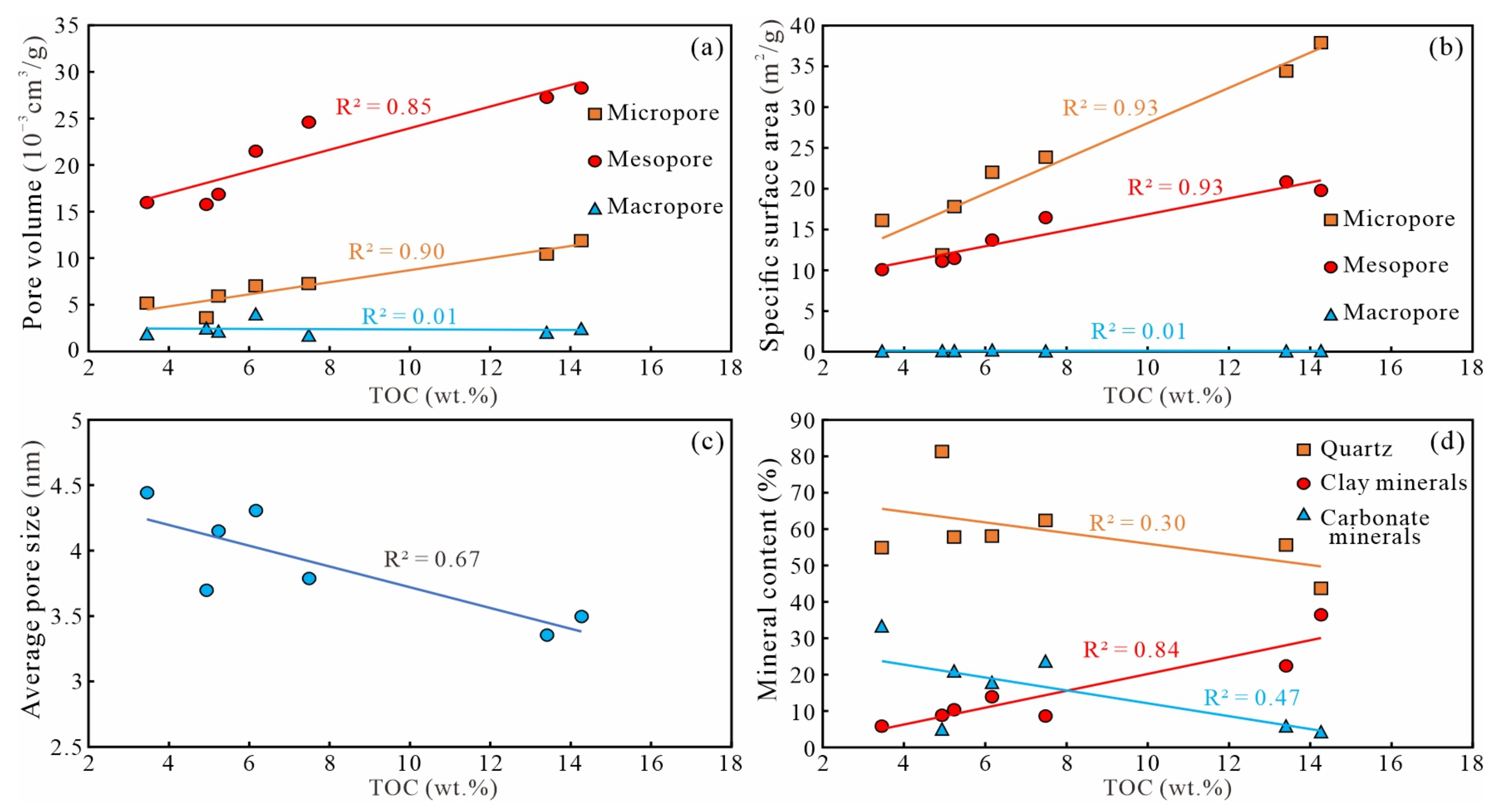

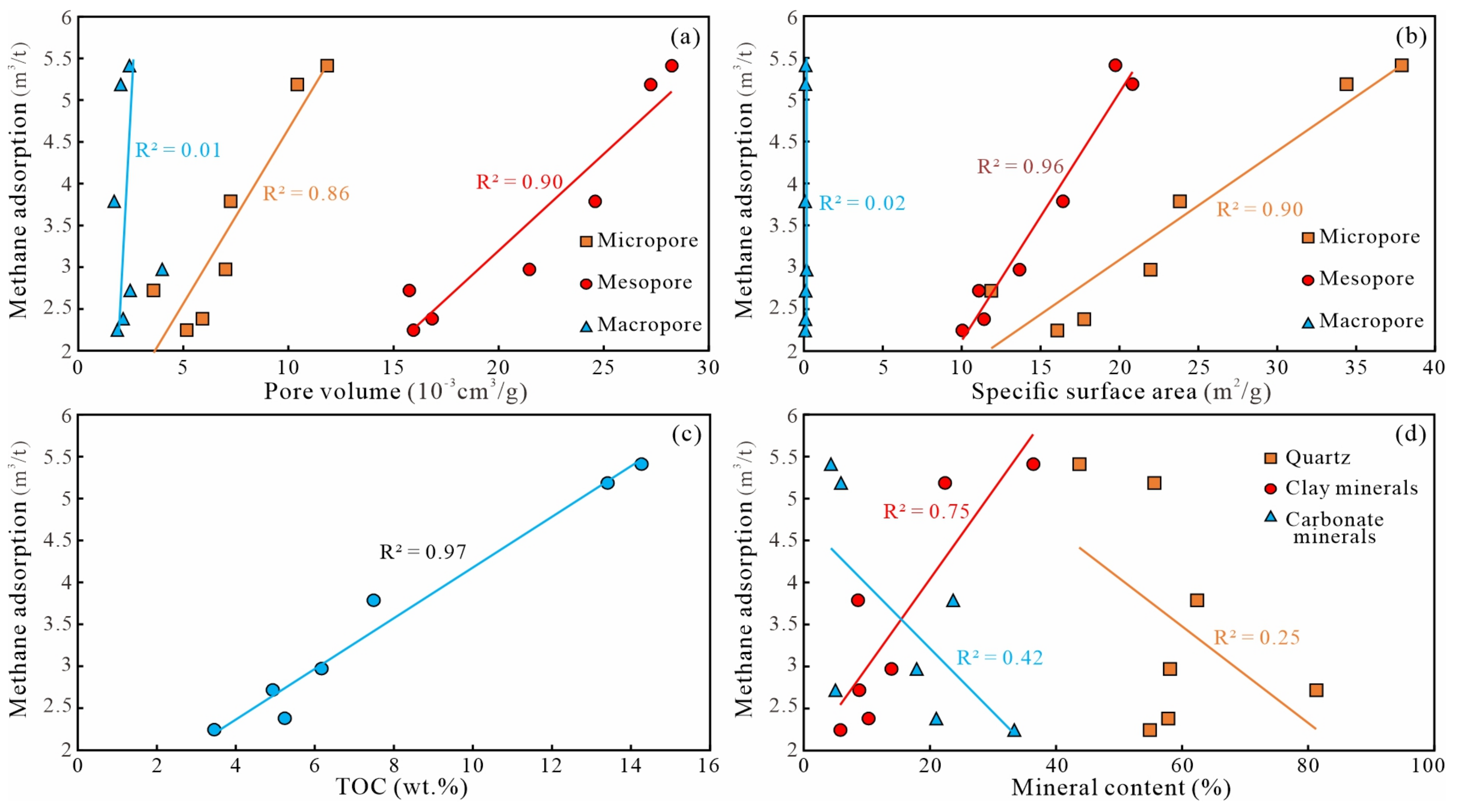
| Sample No. | Depth (m) | TOC (wt.%) | Ro (%) | Kerogen Type | Mineral Contents (%) | ||||
|---|---|---|---|---|---|---|---|---|---|
| Quartz | Feldspar | Clay Minerals | Carbonates | Pyrite | |||||
| P3d-1 | 1215.9 | 4.94 | 2.56 | 81.3 | 1.4 | 8.8 | 5 | 2.4 | |
| P3d-2 | 1222.5 | 7.49 | 2.64 | 62.4 | 2.7 | 8.6 | 23.7 | 2 | |
| P3d-3 | 1222.95 | 3.46 | 2.62 | 54.9 | 4.3 | 5.8 | 33.4 | 1.1 | |
| P3d-4 | 1223.2 | 5.1 | 2.59 | II1 | 58.2 | 6.1 | 10.6 | 22 | 2.4 |
| P3d-5 | 1224.5 | 6.59 | II1 | 50.6 | 17.7 | 17.6 | 8.5 | 4.7 | |
| P3d-6 | 1226.1 | 3.21 | 2.60 | I | 52.1 | 3.8 | 4.7 | 37.6 | 1.2 |
| P3d-7 | 1228.1 | 6.17 | 2.67 | 58.1 | 5.8 | 13.9 | 17.9 | 3.6 | |
| P3d-8 | 1229.6 | 5.48 | 2.65 | I | 74.7 | 3.6 | 10.1 | 8.5 | 2.5 |
| P3d-9 | 1231.3 | 8.6 | 2.66 | I | 77.5 | 3.2 | 9.1 | 6.9 | 2.8 |
| P3d-10 | 1232.6 | 2.6 | II1 | 64 | 4.8 | 9 | 19.2 | 2.2 | |
| P3d-11 | 1233.3 | 10.4 | 2.70 | I | 36.4 | 22.9 | 31 | 5.7 | 2.6 |
| P3d-12 | 1234.2 | 5.32 | 2.67 | I | 57.5 | 5.2 | 26.4 | 5.4 | 4.4 |
| P3d-13 | 1235.2 | 7.55 | 2.69 | I | 66.3 | 5.4 | 14.7 | 9.9 | 3 |
| P3d-14 | 1235.9 | 0.25 | 2.68 | 3.9 | 0.7 | 3.6 | 91.1 | 0.5 | |
| P3d-15 | 1237.2 | 4.6 | I | 80.7 | 3.7 | 7.4 | 5.8 | 1.7 | |
| P3d-16 | 1239.0 | 2.6 | 2.72 | I | 87.2 | 2.9 | 6.1 | 2.4 | 1.1 |
| P3d-17 | 1240.4 | 5 | I | 71.9 | 4 | 6.7 | 16.2 | 0.8 | |
| P3d-18 | 1241.9 | 2.89 | 2.74 | I | 57 | 7.9 | 13.2 | 16.2 | 4.4 |
| P3d-19 | 1243.1 | 10.43 | II1 | 64.7 | 5.3 | 8.9 | 17.7 | 2.5 | |
| P3d-20 | 1244.2 | 13.41 | 2.71 | 55.6 | 7.5 | 22.4 | 5.9 | 6.6 | |
| P3d-21 | 1245.6 | 5.24 | 2.75 | 57.8 | 7.6 | 10.3 | 21 | 2.9 | |
| P3d-22 | 1247.1 | 9.38 | 2.74 | II1 | 53.2 | 6.4 | 16.6 | 18 | 4.5 |
| P3d-23 | 1247.8 | 7.03 | II1 | 44.9 | 10.4 | 15.3 | 24.6 | 4 | |
| P3d-24 | 1248.4 | 10.89 | 2.74 | I | 62.1 | 7.2 | 18.5 | 6.9 | 4.4 |
| P3d-25 | 1249.2 | 14.27 | 2.77 | II1 | 43.7 | 10.5 | 36.4 | 4.3 | 4.4 |
| P3d-26 | 1252.9 | 3.89 | 2.79 | 82.7 | 1.3 | 9.9 | 2.6 | 2.6 | |
| Sample No. | Depth (m) | Average Pore Size (nm) | Pore Volume (cm3/g) | Specific Surface Area (m2/g) | ||||
|---|---|---|---|---|---|---|---|---|
| Micropore | Mesopore | Macropore | Micropore | Mesopore | Macropore | |||
| dl-1 | 1215.9 | 3.697 | 0.00358 | 0.01576 | 0.00247 | 11.873 | 11.085 | 0.106 |
| dl-2 | 1222.5 | 3.787 | 0.00725 | 0.02459 | 0.00171 | 23.827 | 16.426 | 0.073 |
| dl-3 | 1222.9 | 4.441 | 0.00516 | 0.01595 | 0.00185 | 16.063 | 10.050 | 0.080 |
| dl-4 | 1228.1 | 4.306 | 0.00700 | 0.02146 | 0.00399 | 21.973 | 13.663 | 0.175 |
| dl-8 | 1244.2 | 3.354 | 0.01043 | 0.02724 | 0.00202 | 34.395 | 20.828 | 0.084 |
| dl-9 | 1245.6 | 4.148 | 0.00591 | 0.01684 | 0.00214 | 17.770 | 11.422 | 0.092 |
| dl-10 | 1249.2 | 3.495 | 0.01185 | 0.02824 | 0.00243 | 37.888 | 19.755 | 0.105 |
| Sample Location | Depth | TOC (wt. %) | Ro (%) | Quartz (%) | Clay (%) | Carbonate (%) | Total Porosity (%) | Micropore Volume (10−2 cm3/g) | Mesopore + Macropore Volume (10−2 cm3/g) | Desorption Gas Content (m3/t) |
|---|---|---|---|---|---|---|---|---|---|---|
| Woodford [56] | 3721 | 2.0 | 1.51 | 32.0 | 45.8 | 10.1 | 4.7 | 0.6 | 1.9 | — |
| Barnett [56] | 1957 | 3.2 | 2.25 | 46.7 | 36.3 | 7.8 | 3.0 | 0.4 | 1.3 | — |
| Longmaxi Formation in eastern Sichuan [49] | 2394 | 3.5 | 2.91 | 43.7 | 35.7 | 9.1 | 4.78 | 0.56 | 2.75 | 2.83 |
| Dalong Formation in Western Hubei | 1233 | 6.7 | 2.68 | 62.2 | 13.7 | 13.8 | 3.12 | 0.73 | 2.38 | 3.03 |
Disclaimer/Publisher’s Note: The statements, opinions and data contained in all publications are solely those of the individual author(s) and contributor(s) and not of MDPI and/or the editor(s). MDPI and/or the editor(s) disclaim responsibility for any injury to people or property resulting from any ideas, methods, instructions or products referred to in the content. |
© 2023 by the authors. Licensee MDPI, Basel, Switzerland. This article is an open access article distributed under the terms and conditions of the Creative Commons Attribution (CC BY) license (https://creativecommons.org/licenses/by/4.0/).
Share and Cite
Duan, K.; Xie, T.; Wang, Y.; Zhang, Y.; Shi, W.; Lu, Y. Reservoir Characteristics and Their Controlling Factors in Siliceous Shales of the Upper Permian Dalong Formation, Western Hubei Province, South China. Appl. Sci. 2023, 13, 1434. https://doi.org/10.3390/app13031434
Duan K, Xie T, Wang Y, Zhang Y, Shi W, Lu Y. Reservoir Characteristics and Their Controlling Factors in Siliceous Shales of the Upper Permian Dalong Formation, Western Hubei Province, South China. Applied Sciences. 2023; 13(3):1434. https://doi.org/10.3390/app13031434
Chicago/Turabian StyleDuan, Ke, Tong Xie, Yi Wang, Yanlin Zhang, Wanzhong Shi, and Yongchao Lu. 2023. "Reservoir Characteristics and Their Controlling Factors in Siliceous Shales of the Upper Permian Dalong Formation, Western Hubei Province, South China" Applied Sciences 13, no. 3: 1434. https://doi.org/10.3390/app13031434
APA StyleDuan, K., Xie, T., Wang, Y., Zhang, Y., Shi, W., & Lu, Y. (2023). Reservoir Characteristics and Their Controlling Factors in Siliceous Shales of the Upper Permian Dalong Formation, Western Hubei Province, South China. Applied Sciences, 13(3), 1434. https://doi.org/10.3390/app13031434





